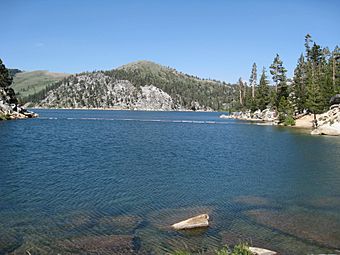Marlette Lake Water System facts for kids
Quick facts for kids |
|
|
Marlette Lake Water System
|
|

Marlette Lake above Lake Tahoe.
|
|
| Lua error in Module:Location_map at line 420: attempt to index field 'wikibase' (a nil value). | |
| Location | Roughly, from Marlette Lake to Virginia City, Nevada |
|---|---|
| Nearest city | Virginia City, Nevada |
| Area | 135.4 acres (54.8 ha) |
| Built | 1873 |
| Engineer | Hermann Schussler, civil engineer |
| NRHP reference No. | 92001162 |
| Added to NRHP | September 16, 1992 |
The Marlette Lake Water System was built to bring water to Virginia City, Nevada. This was during a huge silver mining boom. Today, these amazing structures are recognized as a National Historic Civil Engineering Landmark. They are also listed on the National Register of Historic Places. The area includes many important parts of the system across 135.4 acres (54.8 ha). It was also known as the Virginia and Gold Hill Water Company Water System.
Supplying Water to the Silver Mines
During the silver rush, mines and towns like Virginia City needed a lot of water. They also needed timber for building and mining. To get enough water, engineers came up with a clever plan. They made the dam at Marlette Lake bigger. They also created a new place to store water called Hobart Reservoir.
How the Water System Worked
To move water from the lakes to the towns, a network of structures was built. This included long wooden channels called flumes and strong pipelines. One part of the system was a tunnel that was almost 4,000 feet long! It went right through a mountain divide.
Another clever part was an "inverted siphon" pipe. This special pipe helped water travel across a valley. It used gravity and pressure to push water uphill after it went downhill. This was a very advanced idea for its time.
A Historic Trail Today
Many years ago, the path where the Marlette flume was located is now a popular trail. People enjoy mountain biking and hiking on it. It's a great way to see some of the beautiful nature around Lake Tahoe-Nevada State Park. The part of the water system that collects water is found inside this park today.

